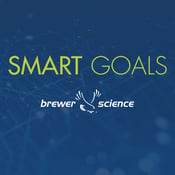Setting goals is an important aspect of development and continued growth. Whether the goal is personal, professional, team-driven, or company-driven, having a “SMART goal” outlined will allow stakeholders to be productive in achieving the specified objective.
What are SMART Goals?
SMART goals are goals that are Specific, Measurable, Attainable, Relevant, and Time-based. The SMART goal outline allows for an organized approach to goal setting for a more successful achievement of the objective.
Why should you use SMART Goals?
Katherine Taylor, Learning and Development Trainer at Brewer Science, hosts trainings for employees on various topics, one of which is “SMART Goals.” It’s widely attended by Brewer Science employees. Taylor explains, “The purpose of the SMART methodology is to provide a template to help write actionable, achievable goals. It is not a rigid formula, it’s more of a checklist of brainstorming questions to guide you when planning a goal so that you have structure, focus and accountability.”
Jessica Albright, Content Marketer, shared about her recent experience attending a SMART Goal Workshop. “Setting goals is essential to growth and development. However sometimes the process can be daunting and overwhelming if the goal isn’t detailed or actionable enough. I am thankful for the SMART Goals workshop, as well as the other development programs Brewer Science offers to assist me in achieving my goals both professionally and personally.”
How do you implement SMART goals?
Setting and achieving goals can be made easy by following the “SMART” acronym.
 Specific. When a goal is not detailed enough, it can seem impossible to achieve. The first step in setting a SMART Goal is by defining the five “W” words, Who, What When, Where, and Why. This ensures that your goal is direct, detailed, and meaningful.
Specific. When a goal is not detailed enough, it can seem impossible to achieve. The first step in setting a SMART Goal is by defining the five “W” words, Who, What When, Where, and Why. This ensures that your goal is direct, detailed, and meaningful.
 Measurable. To track your progress on achieving the goal, there must be a measurable aspect. Define your goal in a way that is quantifiable to track success. This can be done by including a specific percentage, or declared value for success, such as “increase by 20%.” It’s important to consider what “lag” measures are in comparison to “lead” measures, and ensure your goal is defined with lead measures. Lag measures are the “effect” of the lead measure. They include things that happen as a result of an action or after the fact – they are difficult for you to influence. Lead measures are behavioral action items that you can influence.
Measurable. To track your progress on achieving the goal, there must be a measurable aspect. Define your goal in a way that is quantifiable to track success. This can be done by including a specific percentage, or declared value for success, such as “increase by 20%.” It’s important to consider what “lag” measures are in comparison to “lead” measures, and ensure your goal is defined with lead measures. Lag measures are the “effect” of the lead measure. They include things that happen as a result of an action or after the fact – they are difficult for you to influence. Lead measures are behavioral action items that you can influence.
 Attainable. This can also refer to Achievable. This is where you understand if the goal is realistic for you to achieve. This can be influenced by you having the resources and tools available for you to attain the goal. Identifying deficits in skills and resources can help you identify if the goal is worth pursuing.
Attainable. This can also refer to Achievable. This is where you understand if the goal is realistic for you to achieve. This can be influenced by you having the resources and tools available for you to attain the goal. Identifying deficits in skills and resources can help you identify if the goal is worth pursuing.
 Relevant. While you might not physically write down whether a goal is relevant, it’s important to consider this as part of the process to ensure the goal is consistent with your objective and expectations. Ask yourself, “Why am I setting this goal?” and seek to understand if it aligns with your company mission, corporate objective, and overall purpose.
Relevant. While you might not physically write down whether a goal is relevant, it’s important to consider this as part of the process to ensure the goal is consistent with your objective and expectations. Ask yourself, “Why am I setting this goal?” and seek to understand if it aligns with your company mission, corporate objective, and overall purpose.
 Time-based. Identifying a clear deadline will allow you to not only track the success on a schedule but also create targets along the way to ensure you meet small objectives on a track to achieving a larger objective. It’s important to be specific in setting time-based goals, such as including a specific date or calendar event.
Time-based. Identifying a clear deadline will allow you to not only track the success on a schedule but also create targets along the way to ensure you meet small objectives on a track to achieving a larger objective. It’s important to be specific in setting time-based goals, such as including a specific date or calendar event.

Establishing goals is essential to continue developing and advancing a team or individual. By setting a SMART goal, that is Specific, Measurable, Attainable, Relevant, and Time-based – you will be on track for achieving your objective. The Learning and Development Team at Brewer Science strives to offer meaningful development opportunities to support Brewer Science’s inclusive culture and promote continuous growth and innovation. Learn more about professional development and technology innovation-related topics on our blog. Experience more of Brewer Science’s vision and continuous growth culture by visiting the Careers section of the website.


Subscribe to Our Blog